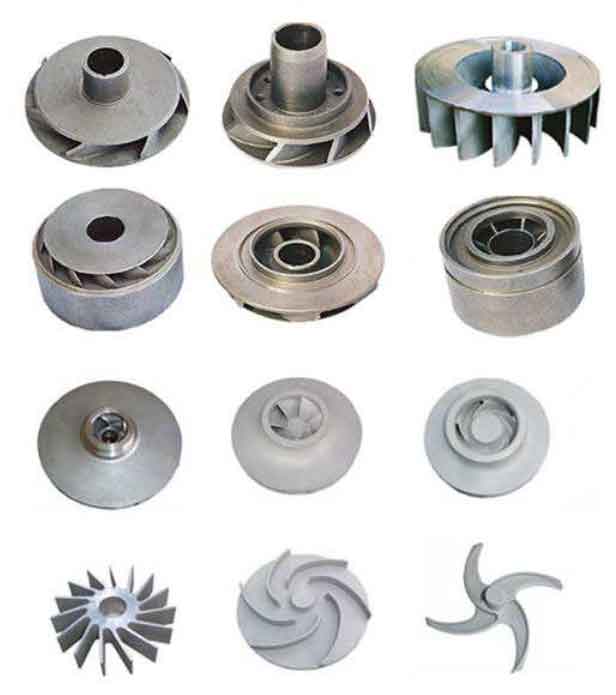Abstract: This paper focuses on the impeller casting process design and optimization using the AnyCasting software. The impeller, made of ZAlSi9Cu2Mg aluminum-silicon alloy, is studied through a combination of casting process design optimization and numerical simulation. The pouring system is designed according to its structural characteristics, and the resin sand molding core-making and hot-box sand casting process are selected. Numerical simulation is conducted to predict potential casting defects. Through analysis and optimization, a feasible casting process scheme is proposed, ensuring the quality of the impeller products.

1. Introduction
Aluminum alloy castings are widely used in industry due to their excellent mechanical properties, such as no tendency for hot tearing, good casting performance, low linear shrinkage, ease of recycling, environmental friendliness, and high gas tightness. However, defects can occur during the actual production of aluminum alloy castings, making the design of the casting process scheme crucial for the quality and efficiency of the castings. In recent years, numerical simulation technology has been increasingly applied by scholars both domestically and internationally for casting process simulation.
2. Material and Structural Characteristics of the Casting
The impeller is made of ZAlSi9Cu2Mg aluminum-silicon alloy, and the casting must be free from cracks, porosity, sand holes, shrinkage porosity, and shrinkage cavities. The chemical composition of ZL111 aluminum alloy is shown in Table 1.
Table 1: Chemical Composition of ZL111 Aluminum Alloy (%)
| Element | Si | Cu | Mg | Mn | Ti | Zn | Fe |
|---|---|---|---|---|---|---|---|
| Content | 8–10 | 1.3–1.8 | 0.4–0.5 | 0.1–0.35 | 0.1–0.35 | ≤0.1 | ≤0.4 |
The impeller has a maximum outer dimension of 920 mm and an average wall thickness of 7 mm. The wall thickness is uniform at the upper and lower parts in contact with the blades, with a minimum thickness of 6 mm at the blades. The maximum wall thickness is 90 mm at the part mating with the rotating shaft, and the maximum and minimum bore diameters are 580 mm and 110 mm, respectively.
3. Design of the Pouring System for the Impeller
Due to the impeller’s medium size and simple structure, as well as its production in large quantities, the parting surface is selected at the maximum cross-section of the casting, with thick cylindrical sections located above to facilitate the placement of risers for feeding. The design of the pouring system includes the selection of the pouring system type, the location of the ingate on the casting, and the calculation of the cross-sectional areas of the choke, sprue, runner, and ingate. The pouring system for the impeller is designed as an open, medium-flow type, with a cross-sectional area ratio of Σsprue : Σrunner : Σingate = 1:2:3.
4. Numerical Simulation of the Casting Process
The 3D pouring model of the impeller casting process is created in PRO/E software, exported as an STL file, and imported into the AnyCasting software for numerical simulation. The material properties of the casting, core, and mold sand are selected from the DBASE material library. The pouring time is set to 14 seconds, the pouring temperature to 720°C, and the initial temperature of the furan resin sand to 25°C. The number of variable mesh elements is planned to be 10 million. Table 2 and Table 3 list the thermophysical properties of the furan resin sand and aluminum alloy ZL111, respectively.
Table 2: Thermophysical Properties of Furan Resin Sand
| Temperature (°C) | Density (kg/m³) | Specific Heat (J/(kg·K)) | Thermal Conductivity (W/(m·K)) | Thermal Expansion Coefficient (1/K) |
|---|---|---|---|---|
| 100 | 1460 | 676 | 0.70 | 3.1×10⁻⁶ |
| 300 | 1458 | 993 | 0.70 | 3.2×10⁻⁶ |
| 550 | 1410 | 1074 | 0.60 | 3.8×10⁻⁶ |
| 2000 | 1370 | 1333 | 1.60 | 5.4×10⁻⁶ |
Table 3: Thermophysical Properties of Aluminum Alloy ZL111
| Property | Value |
|---|---|
| Density | 2770 kg/m³ |
| Specific Heat | 963 J/(kg·K) |
| Thermal Conductivity | 96 W/(m·K) |
| Liquidus Temperature | 590°C |
| Solidus Temperature | 520°C |
| Latent Heat | 3.89×10⁵ J/kg |
| Feeding Rate | 0.7 |
The filling process is smooth, with no splashing or significant underfilling, meeting the technical requirements for the impeller casting process.
The solidification sequence of the casting is such that the edges solidify first, followed by the riser, and the central thick section is the last to solidify.
5. Defect Analysis and Process Optimization
According to the solidification sequence, shrinkage porosity defects are formed in the thick central section of the casting due to inadequate feeding from the riser. The defect probability distribution obtained using the RMM criterion confirms this, with nearly 90% of the tendency for shrinkage porosity and shrinkage cavities in this area.
To optimize the casting process, chilled iron is placed in the hot spots of the thick central section, and the size and number of risers are adjusted to improve feeding efficiency and eliminate defects caused by hot spots.
After optimization, the casting is essentially free of defects, with a significant improvement in casting quality. Testing reveals no porosity or shrinkage defects, and the casting structure is dense, meeting the requirements for production and practical use.
6. Conclusion
This paper presents a study on the process simulation and optimization of a large aluminum-silicon alloy impeller casting using AnyCasting. The research results show that:
- Before optimization, numerical simulation results indicate that the thick central section of the casting solidifies last compared to the riser, confirmed by the defect probability distribution, leading to the formation of shrinkage porosity.
- After optimization, the desired solidification sequence is achieved, with improved feeding and increased solidification rate in the thick sections, resulting in no shrinkage porosity or shrinkage cavities in the casting.
- The impeller castings produced after optimization are free of surface porosity and internal defects, with a dense structure, meeting production and practical use requirements.
